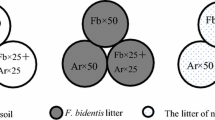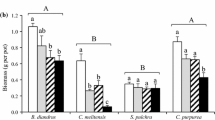Abstract
A critical stage in the establishment of new individuals is seedling emergence and litter is a main factor affecting this stage. Recent research found that adults of Chuquiraga avellanedae are over-dispersed. Among several mechanisms, this pattern might be due to the negative influences of adults on seedlings through root competition. We performed field and glasshouse experiments to evaluate (i) the effects of C. avellanedae leaf litter and root presence on the emergence of conspecific seedlings, and (ii) the effects of leaf litter type (C. avellanedae litter, inert litter, no litter) and seed burial depth (seed at the surface or buried) on the emergence of C. avellanedae and Nassella tenuis (dominant grass) seedlings. The field experiment demonstrated root competition from adult plants on shrub seedlings, reducing seedling emergence. However, the effect of root competition did not differ between microsites (under-shrubs vs. between-shrubs). We dismiss the effect of allelopathy because inert litter (i.e., plastic leaves) had the same negative effect as C. avellanedae litter, indicating a mechanical effect. The glasshouse experiment revealed a species-specific response of seedling emergence. C. avellanedae litter limits the emergence of conspecific seedlings but was neutral with regard to the emergence of grass seedlings (N. tenuis). No differences in root competition between microsites and reduction of shrub seedlings by litter suggest that the over-dispersed pattern found for C. avellanedae is caused, at least partially, by litter effects on seedling emergence.



Similar content being viewed by others
References
Aguiar MR, Sala OE (1994) Competition, facilitation, seed distribution and the origin of patches in a Patagonian steppe. Oikos 70:26–34
Aguiar MR, Sala OE (1999) Patch structure, dynamics and implications for the functioning of arid ecosystems. TREE 14:273–277
Aguiar MR, Soriano A, Sala OE (1992) Competition and facilitation in the recruitment of seedlings in Patagonian steppe. Funct Ecol 6:66–70
Andersen MC (1993) Diaspore morphology and seed dispersal in several wind-dispersed Asteraceae. Am J Bot 80:487–492
Armas C, Pugnaire FI (2005) Plant interactions govern population dynamics in a semi-arid plant community. J Ecol 93:978–989
Barbier N, Couteron P, Lefever R, Deblauwe V, Lejeune O (2008) Spatial decoupling of facilitation and competition at the origin of gapped vegetation patterns. Ecology 89:1521–1531
Barritt AR, Facelli JM (2001) Effects of Casuarina pauper litter and grove soil on emergence and growth of understorey species in arid lands of South Australia. J Arid Environ 49:569–579
Bates D, Maechler M, Bolker B, Walker S (2015) Fitting linear mixed-effects models using lme4. J Stat Softw 67:1–48
Beeskow AM, Elissalde NO, Rostagno CM (1995) Ecosystem changes associated with grazing intensity on the Punta Ninfas rangelands of Patagonia, Argentina. J Range Manag 48:517–522
Bertiller MB, Beeskow AM, Coronato F (1991) Seasonal environmental variation and plant phenology in arid Patagonia (Argentina). J Arid Environ 21:1–11
Bisigato AJ, Bertiller MB (2004a) Temporal and micro-spatial pattering of seedling establishment. Consequences for patch dynamics in the southern Monte. Argentina Plant Ecol 174:235–246
Bisigato AJ, Bertiller MB (2004b) Seedling recruitment of perennial grasses in degraded areas of the Patagonian Monte. J Range Manage 57:191–196
Bisigato AJ, Hardtke LA, del Valle HF, Bouza PJ, Palacio RG (2016) Regional-scale vegetation heterogeneity in northeastern Patagonia: environmental and spatial components. Community Ecol 17:8–16
Bonanomi G, Sicurezza MG, Caporaso Esposito A, Mazzoleni S (2006) Phytotoxicity dynamics of decaying plant material. New Phytol 169:571–578
Bosco T, Bertiller MB, Carrera AL (2015) Micro-environmental conditions affect grass and shrub seedling emergence in denuded areas of the arid Patagonian Monte, Argentina. Flora 210:66–71
Bosco T, Bertiller MB, Carrera AL (2018) Abiotic factors affect the recruitment and biomass of perennial grass and evergreen shrub seedlings in denuded areas of Patagonian Monte rangelands. J Environ Manage 218:118–128
Bosy JL, Reader RJ (1995) Mechanisms underlying the suppression of forb seedling emergence by grass (Poa pratensis) litter. Funct Ecol 9:635–639
Brearley FQ, Press MC, Scholes JD (2003) Nutrients obtained from leaf litter can improve the growth of dipterocarp seedlings. New Phytol 160:101–110
Busso CA (1997) Towards an increased and sustainable production in semi-arid rangelands of central Argentina: two decades of research. J Arid Environ 36:197–210
Callaway RM, DeLucia EH, Moore D, Nowak R, Schlesinger WH (1996) Competition and facilitation: contrasting effects of Artemisia tridentata on desert vs Monte pines. Ecology 77:2130–2141
Campanella MV, Bertiller MB (2008) Plant phenology, leaf traits, and leaf litterfall of contrasting life forms in the arid Patagonian Monte, Argentina. J Veg Sci 19:75–85
Campanella MV, Bertiller MB (2009) Leafing patterns and leaf traits of four evergreen shrubs in the Patagonian Monte, Argentina. Acta Oecol 35:831–837
Campanella MV, Bertiller MB (2010) Leaf litterfall patterns of perennial plant species in the arid Patagonian Monte, Argentina. Plant Ecol 210:43–52
Campanella MV, Rostagno CM, Videla LS, Bisigato AJ (2016) Interacting effects of soil degradation and precipitation on plant productivity in NE Patagonia, Argentina. Arid Land Res Manag 30:79–88
Carson WP, Peterson CJ (1990) The role of litter in an old-field community: impact of litter quantity in different seasons on plant species richness and abundance. Oecologia 85:8–13
Casalini AI, Bisigato AJ (2018) Stress-gradient hypothesis and plant distribution along ecotonal gradients. Austral Ecol 43:807–816
Cavieres LA, Chacón P, Peñaloza A, Molina-Montenegro M, Arroyo MTK (2007) Leaf litter of Kageneckia angustifolia D. Don (Rosaceae) inhibits seed germination in sclerophyllous montane woodlands of central Chile. Plant Ecol 190:13–22
Chambers JC (2000) Seed movements and seedling fates in disturbed sagebrush steppe ecosystems: implications for restoration. Ecol Appl 10:1400–1413
Chapman SK, Feller IC (2011) Away-field advantage: mangrove seedlings grow best in litter from other mangrove species. Oikos 120:1880–1888
Chartier MP, Rostagno CM (2006) Soil erosion thresholds and alternative states in northeastern Patagonian Rangelands. Rangel Ecol Manag 59:616–624
Chartier MP, Rostagno CM, Videla LS (2013) Selective erosion of clay, organic carbon and total nitrogen in grazed semiarid rangelands of northeastern Patagonia, Argentina. J Arid Environ 88:43–49
Cipriotti PA, Aguiar MR (2005) Interspecific competition interacts with the spatial distribution of a palatable grass to reduced its recruitments. Rangel Ecol Manag 58:393–399
Cipriotti PA, Aguiar MR (2015) Is the balance between competition and facilitation a driver of the patch dynamics in arid vegetation mosaics? Oikos 124:139–149
Defossé GE, Bertiller MB, Robberecht R (1997) Effects of topography, soil moisture, wind and grazing on Festuca seedlings in a Patagonian grassland. J Veg Sci 8:677–684
Facelli JM, Pickett STA (1991a) Plant litter: light interception and effects on an old-field plant community. Ecology 72:1024–1031
Facelli JM, Pickett STA (1991b) Plant litter: its dynamics and effects on plant community structure. Bot Rev 57:1–32
Facelli JM, Pickett STA (1991c) Indirect effects of litter on woody seedlings subject to herb competition. Oikos 62:129–138
Fay PA, Schultz MJ (2009) Germination, survival, and growth of grass and forb seedlings: effects of soil moisture variability. Acta Oecol 35:679–684
Flores J, Jurado E (2003) Are nurse–protege interactions more common among plants from arid environments? J Veg Sci 14:911–916
Fowler NL (1986a) Microsite requirements for germination and establishment of three grass species. Am Midl Nat 115:131–145
Fowler NL (1986b) The role of competition in plant communities in arid and semiarid regions. Ann Rev Ecol Syst 17:89–110
Franzese J, Ghermandi L, Donaldo B (2009) Post-fire shrub recruitment in a semi-arid grassland: the role of microsites. J Veg Sci 20:215–259
Ghermandi L (1995) The effect of the awn on the burial and germination of Stipa speciosa (Poaceae). Acta Oecol 16:719–728
Goldberg DE, Barton AM (1992) Patterns and consequences of interspecific competition in natural communities: field experiments with plants. Am Nat 139:771–801
Gomez-Aparicio L (2008) Spatial patterns of recruitment in Mediterranean plant species: linking the fate of seeds, seedlings and saplings in heterogeneous landscapes at different scales. J Ecol 96:1128–1140
Hovstad KA, Ohlson M (2009) Conspecific versus heterospecific litter effects on seedling establishment. Plant Ecol 204:33–42
IPCC (2007) Technical summary. In: Solomon S, Qin D, Manning M, et al. (eds.) Climate change 2007: the physical science basis. Contribution of Working Group I to the Fourth Assessment Report of the Intergovernmental Panel on Climate Change. Cambridge: Cambridge University Press.
Jensen K, Gutekunst K (2003) Effect of litter on establishment of grassland plant species: the role of seed sized and successional status. Basic Appl Ecol 4:579–587
Jurena PN, Archer S (2003) Woody plant establishment and spatial heterogeneity in grasslands. Ecology 84:907–919
Liu G, Wan L, He F, Tong Z, Liu Z, Li X (2016) Effects of litter, seed position, and water availability on establishment of seedlings for two semiarid grass species. Plant Ecol 217:277–287
Loydi A, Eckstein RL, Otte A, Donath TW (2013) Effects of litter on seedling establishment in natural and semi-natural grasslands: a meta-analysis. J Ecol 101:454–464
Loydi A, Donath TW, Otte A, Eckstein RL (2015) Negative and positive interactions among plants: effect of competitors and litter on seedling emergence and growth of forest and grassland species. Plant Biol 17:667–675
Mazzoleni S, Bonanomi G, Incerti G, Chiusano ML, Termolino P, Mingo A, Senatore M, Giannino F, Cartenì F, Rietkerk M, Lanzotti V (2015) Inhibitory and toxic effects of extracellular self-DNA in litter: a mechanism for negative plant-soils feedbacks? New Phytol 205:1195–1210
Merino-Martín L, Courtauld C, Commander L, Turner S, Lewandrowski W, Stevens J (2017) Interactions between seed functional traits and burial depth regulate germination and seedling emergence under water stress in species form semi-arid environments. J Arid Environ 147:25–33
Nogueira C, Nunes A, Bugalho MN, Branquinho C, McCulley RL, Caldeira MC (2018) Nutrient addition and drought interact to change the structure and decrease the functional diversity of a Mediterranean Grassland. Front Ecol Evol 6:155
R Core Team (2018) R: A language and environment for statistical computing. R Foundation for Statistical Computing, Vienna. https://www.R-project.org/.
Rey Benayas JM, Fernández A, Aubenau A (2007) Clipping herbaceous vegetation improves early performance of planted seedlings of the Mediterranean shrub Quercus coccifera. Web Ecol 7:120–131
Rotundo JL, Aguiar MR (2005) Litter effects on plant regeneration in arid lands: a complex balance between seed retention, seed longevity and soil-seed contact. J Ecol 93:829–838
Siffredi GL (2012) Guía de evaluación del pastoreo de cuadros INTA EEA Bariloche. Propastizal, Ley Ovina Río Negro
Singh HP, Batish DR, Kohli RK (1999) Autotoxicity: concept, organisms, and ecological significance. Crit Rev Plant Sci 18:757–772
Talamo A, Barchuk AH, Garibaldi LA, Trucco CE, Cardozo S, Mohr F (2015) Disentangling the effects of shrubs and herbivores on tree regeneration in a dry Chaco forest (Argentina). Oecologia 178:847–854
Vaz PG, Bugalho MN, Fedriani JM, Branco M, Lecomte X, Nogueira C, Caldeira MC (2019) Unravelling associations between tree-seedling performance, herbivory, competition, and facilitation in high nature value farmlands. J Environ Manage 232:1066–1074
Westoby M, Leishman M, Lord J, Poorter H, Schoen DJ (1996) Comparative ecology of seed size and dispersal. Phil Trans R Soc Lond B 351:1309–1318
Winn AA (1985) Effects of seed size and microsite on seedling emergence of Prunella vulgaris in four habitats. J Ecol 73:831–840
Xiong S, Nilsson C (1999) The effects of plant litter on vegetation: a meta-analysis. J Ecol 87:984–994
Zuur AF, Ieno EN, Walker N et al (2009) Mixed effects models and extensions in ecology with R. Springer, New York
Acknowledgements
We are especially grateful to Lina Videla and Cristian Barrionuevo for their assistance during field and laboratory work. Anonymous reviewers and Michael John Lawes provided thoughtful comments on the manuscript. Ana Casalini and Gustavo Pazos helped with data analysis. This work was supported by the National Research Council of Argentina CONICET (PIP 11220170100981). This paper was written within the framework of the PUE-IPEEC-2016 22920160100044. MVC and AJB are CONICET researchers.
Author information
Authors and Affiliations
Corresponding author
Additional information
Communicated by Michael John Lawes.
Publisher's Note
Springer Nature remains neutral with regard to jurisdictional claims in published maps and institutional affiliations.
Electronic supplementary material
Below is the link to the electronic supplementary material.
Rights and permissions
About this article
Cite this article
Campanella, M.V., Bisigato, A.J. Conspecific leaf litter and root competition inhibits shrub emergence in the Patagonian steppe. Plant Ecol 220, 985–993 (2019). https://doi.org/10.1007/s11258-019-00968-3
Received:
Accepted:
Published:
Issue Date:
DOI: https://doi.org/10.1007/s11258-019-00968-3




